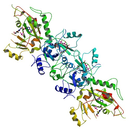
You are using an unsupported browser. Please upgrade your browser to a newer version to get the best experience on Toxin, Toxin Target Database.
Exotoxin A (Pseudomonas aeruginosa) (T3D2607)
| Record Information | |||||||||||
|---|---|---|---|---|---|---|---|---|---|---|---|
| Version | 2.0 | ||||||||||
| Creation Date | 2009-07-06 18:11:30 UTC | ||||||||||
| Update Date | 2014-12-24 20:25:46 UTC | ||||||||||
| Accession Number | T3D2607 | ||||||||||
| Identification | |||||||||||
| Common Name | Exotoxin A (Pseudomonas aeruginosa) | ||||||||||
| Class | Protein | ||||||||||
| Description | Pseudomonas exotoxin (or exotoxin A) is an exotoxin produced by Pseudomonas aeruginosa. (2) | ||||||||||
| Compound Type |
| ||||||||||
| Protein Structure |  | ||||||||||
| Synonyms |
| ||||||||||
| Chemical Formula | Not Available | ||||||||||
| Average Molecular Mass | 69283.345 g/mol | ||||||||||
| CAS Registry Number | Not Available | ||||||||||
| Sequence | Not Available | ||||||||||
| Chemical Taxonomy | |||||||||||
| Description | Not Available | ||||||||||
| Kingdom | Organic Compounds | ||||||||||
| Super Class | Organic Acids | ||||||||||
| Class | Carboxylic Acids and Derivatives | ||||||||||
| Sub Class | Amino Acids, Peptides, and Analogues | ||||||||||
| Direct Parent | Peptides | ||||||||||
| Alternative Parents | Not Available | ||||||||||
| Substituents | Not Available | ||||||||||
| Molecular Framework | Not Available | ||||||||||
| External Descriptors | Not Available | ||||||||||
| Biological Properties | |||||||||||
| Status | Detected and Not Quantified | ||||||||||
| Origin | Exogenous | ||||||||||
| Cellular Locations | Not Available | ||||||||||
| Biofluid Locations | Not Available | ||||||||||
| Tissue Locations | Not Available | ||||||||||
| Pathways | Not Available | ||||||||||
| Applications | Not Available | ||||||||||
| Biological Roles | Not Available | ||||||||||
| Chemical Roles | Not Available | ||||||||||
| Physical Properties | |||||||||||
| State | Liquid | ||||||||||
| Appearance | Clear solution. | ||||||||||
| Experimental Properties |
| ||||||||||
| Predicted Properties | Not Available | ||||||||||
| Spectra | |||||||||||
| Spectra |
| ||||||||||
| Toxicity Profile | |||||||||||
| Route of Exposure | Ingestion (4) ; inhalation (4) ; dermal (4) | ||||||||||
| Mechanism of Toxicity | Pseudomonas exotoxin has exactly the same mechanism of action as the diphtheria toxin; it causes the ADP ribosylation of eucaryotic elongation factor 2 resulting in inhibition of protein synthesis in the affected cell. Although it is partially-identical to diphtheria toxin, it is antigenically-distinct. It utilizes a different receptor on host cells than diphtheria toxin, but otherwise it enters cells in the same manner and has the exact enzymatic mechanism. (3) | ||||||||||
| Metabolism | Free toxin may be removed by opsonization via the reticuloendothelial system (primarily the liver and kidneys) or it may be degraded through cellular internalization via the lysosomes. Lysosomes are membrane-enclosed organelles that contain an array of digestive enzymes, including several proteases. | ||||||||||
| Toxicity Values | LD50: 3 ug/mg (Intravenous, Mouse) (1) | ||||||||||
| Lethal Dose | Not Available | ||||||||||
| Carcinogenicity (IARC Classification) | No indication of carcinogenicity to humans (not listed by IARC). | ||||||||||
| Uses/Sources | Pseudomonas exotoxin (or exotoxin A) is an exotoxin produced by Pseudomonas aeruginosa. (2) | ||||||||||
| Minimum Risk Level | Not Available | ||||||||||
| Health Effects | Pseudomonas exotoxin (or exotoxin A) is an exotoxin produced by Pseudomonas aeruginosa. Pseudomonas aeruginosa can infect damaged tissues or people with reduced immunity. If such colonisations occur in critical body organs such as the lungs, the urinary tract, and kidneys, the results can be fatal. (2) | ||||||||||
| Symptoms | Pseudomonas exotoxin (or exotoxin A) is an exotoxin produced by Pseudomonas aeruginosa. Pseudomonas aeruginosa can infect damaged tissues or people with reduced immunity. The symptoms of such infections are generalised inflammation and sepsis. (2) | ||||||||||
| Treatment | Not Available | ||||||||||
| Normal Concentrations | |||||||||||
| Not Available | |||||||||||
| Abnormal Concentrations | |||||||||||
| Not Available | |||||||||||
| External Links | |||||||||||
| DrugBank ID | Not Available | ||||||||||
| HMDB ID | Not Available | ||||||||||
| PubChem Compound ID | Not Available | ||||||||||
| ChEMBL ID | Not Available | ||||||||||
| ChemSpider ID | Not Available | ||||||||||
| KEGG ID | Not Available | ||||||||||
| UniProt ID | P11439 | ||||||||||
| OMIM ID | |||||||||||
| ChEBI ID | Not Available | ||||||||||
| BioCyc ID | Not Available | ||||||||||
| CTD ID | Not Available | ||||||||||
| Stitch ID | Pseudomonas exotoxin | ||||||||||
| PDB ID | 1AER | ||||||||||
| ACToR ID | Not Available | ||||||||||
| Wikipedia Link | Pseudomonas_exotoxin | ||||||||||
| References | |||||||||||
| Synthesis Reference | Not Available | ||||||||||
| MSDS | T3D2607.pdf | ||||||||||
| General References |
| ||||||||||
| Gene Regulation | |||||||||||
| Up-Regulated Genes | Not Available | ||||||||||
| Down-Regulated Genes | Not Available | ||||||||||
Targets
- General Function:
- Translation elongation factor activity
- Specific Function:
- Catalyzes the GTP-dependent ribosomal translocation step during translation elongation. During this step, the ribosome changes from the pre-translocational (PRE) to the post-translocational (POST) state as the newly formed A-site-bound peptidyl-tRNA and P-site-bound deacylated tRNA move to the P and E sites, respectively. Catalyzes the coordinated movement of the two tRNA molecules, the mRNA and conformational changes in the ribosome.
- Gene Name:
- EEF2
- Uniprot ID:
- P13639
- Molecular Weight:
- 95337.385 Da
References
- Wikipedia. Pseudomonas aeruginosa. Last Updated 8 August 2009. [Link]